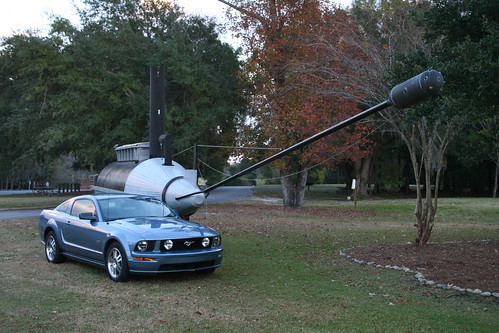DAVID sticks it to 'em

[ FOR BETTER RESOLUTION, CLICK ON IMAGE ]
This appendage which looks like King Kong's second hand Q-Tip looms from the bow of a replica of the C.S.S. DAVID. Nicknamed the LITTLE DAVID, it replicates the famous Confederate vessel which revolutionized warfare by attacking the Union vessel, NEW IRONSIDES in Charleston Harbor, October 5, 1863, using a manually delivered torpedo. It could be said that the DAVID really stuck it to the enemy.
This attack came many years before the era of self propelled and gyro guided torpedoes. In the World War II submarine movies, the commander orders, "Fire 1....Fire 2.....Fire 3.." and we see those long tubular fish leave the sub with a big "WOOSH" and a thousand bubbles. The DAVID had its torpedo fastened to a long staff which was used to ram the explosive charge into the enemy vessel. It did not have the luxury of watching the impact at great distance through a periscope. Once the torpedo exploded, that staff didn't seem so long at all. This technique is akin to strapping a hand grenade on to one end of a long broom stick then trying to sneak up on an armed enemy soldier to blow him up while you are still holding the stick and while he's still quite capable of shooting you. This being attempted while you're wearing snowshoes. Such was the DAVID'S ability to beat a hasty retreat after the attack.
This concept took more daring than genius. It is the antithesis of today's smart bombs with which the enemy is dispatched at great distance by remote control and seen by the folks back home more as a video game than actual warfare. It's a safe bet that the boys aboard C. S. S. DAVID were not watching the attack upon NEW IRONSIDES with detached interest. This was intimate contact with the enemy.
The replica was begun in 1970 by students of the Trident Technical College at North Charleston, SC, in preparation for South Carolina's Tricentennial celebration. In 2004, members of the U.S. Submarine Veterans, Inc., completely refurbished the replica and restored it to the actual vessel's original specifications. The group devoted more than 5,000 man hours to this project. We suspect that there must have been a few woman hours given to this project as well. Funding for this restoration was made possible by proceeds from the annual antique tractor and engine show at the Berkeley Museum.
The site on which it rests is Stoney Landing in Berkeley County, SC, the very place where the original was constructed.


0 Comments:
Post a Comment
<< Home